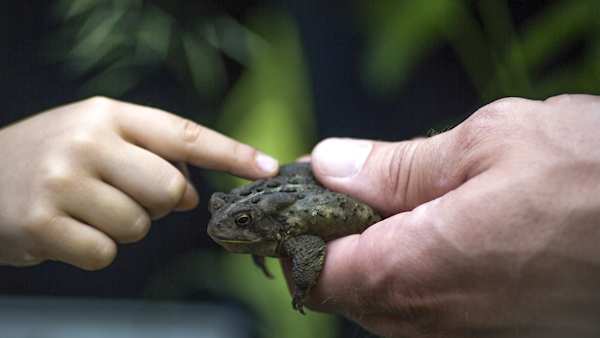Hopping Their Way to Your Heart

Guest Blog written by 2015 Environmental Visual Communication student Lian Jong
Lizards and snakes and frogs oh my!
These groups are a part of a broader scale of animals called amphibians and reptiles and the scientists who study them are called herpetologists. The Royal Ontario Museum is home to 51,000 catalogued herpetology specimens and over 20,000 catalogued tissues – that’s the largest tissue collection in the world! The collection contains specimens from around the world including South-East Asia, Australia, South America, the Caucasus and many from South West United States. But who collects, catalogues and cares for the specimens once they enter the ROM? One vital herpetology team member is Amy Lathrop, a herpetology technician. “I have loved frogs ever since I was a little kid,” says Amy. “As I was going through university, I had a professor who studied frogs and working with him I realized that I could get paid to keep doing what I love doing.”



One of Amy’s favourite specimens in the collection is the Polypedates fae, the largest tree frog in Vietnam. “It’s about 8 inches long from the tip of its nose to its cloaca* and that doesn’t include its legs!” says Amy. “It has huge webs on its feet and you usually don’t see the frogs because they hide high way up in the trees. I was walking up a stream and heard one calling, when all of a sudden BAM! - it landed on a rock right in front of me!” she continues. “I found it and picked it up and it just kind of holds you back. It’s a beautiful frog.”
* Cloaca is the common opening that accommodates the digestive, urinary, and reproductive tracts of many vertebrates, including frogs.

Why reptiles and amphibians? What makes them so special? “Reptiles and amphibians are important because they are in almost every ecosystem and represent mid-level predators and prey. Without them present, ecosystems start to go out of balance,” states Amy. Moreover, amphibians are usually very sensitive to environmental changes, which offer a warning sign that significant changes are occurring. They play a key role in keeping an ecosystem healthy and in helping us to understand the effects of our impacts on the environment. “Amphibians are entering a crisis and we’re just scratching the surface of where that’s coming from,” says Amy. “There’s a chytrid fungus that’s attacking a lot amphibians. There are samples of frogs from 100 years ago that have this fungus on them but they’re only succumbing to it now. We’re trying to learn why.”

What advice does Amy have for any hatchling herpetologists? Get involved and immerse yourself in all things herpetology. “There are herpetology clubs, become knowledgeable, get a nice foundation in biology and look and see where technology is going,” says Amy. “If there’s anything you do right now that you love doing, find a way to get paid to do it. With herpetology you can work in a zoo, a museum, you can do surveys across Canada or internationally! Get on the Internet and find places that are calling for help. Keep pushing and keep looking for opportunities because there are a lot out there,” she suggests.

There’s more than meets the eye at the ROM. Each collection, each specimen has its own story to tell and contains precious information that that can play a vital role in research. From the largest frog in Vietnam to some highly venomous snakes, the herpetology collection is one to be marveled. “I love it. Everyday is different and this job is not just taking care of a collection,” shares Amy. “It’s exciting other people about herpetology. It’s exciting people about the museum and research. I think if I was only studying frogs I could have burned out. This job has brought me the opportunity to excite people and that in itself is exciting.”
